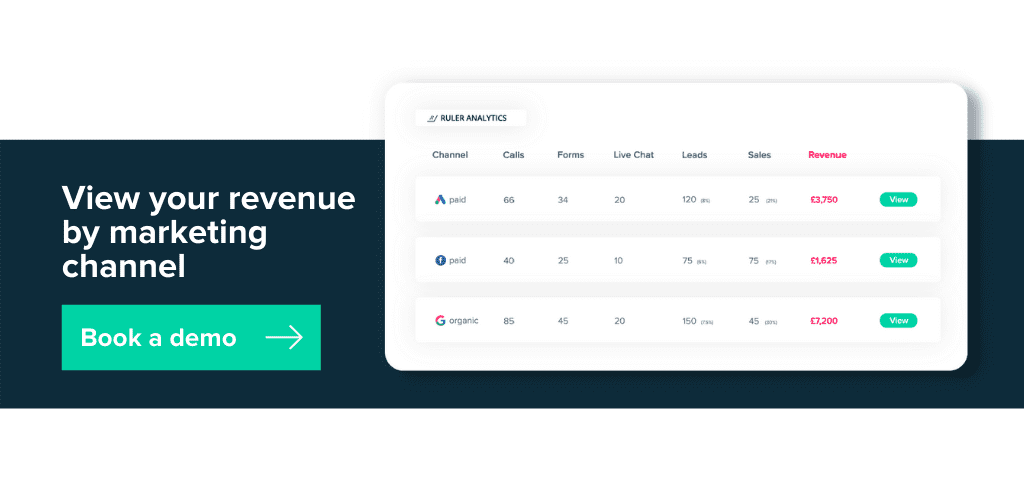Don’t get us wrong, Ruler Analytics is incredibly useful for all marketers. But there are situations where we’re an unparalleled tool. We share 7 use cases where Ruler is a must for any marketer.
Ruler is a marketing attribution and call tracking tool. That means there are a lot of features you can use to get more out of your marketing. The key to it all is data.
Data is the number one commodity for any marketing team. Without it, you’re marketing blind. With it, you have endless insights into how you can further your marketing and use it to drive meaningful interactions with your website.
So, let’s deep dive into 7 cases where Ruler Analytics is an absolute necessity.
We’ll go through how Ruler can:
Let’s get stuck in.
Before we get started, it’s worth going through exactly how Ruler works.
Users land on your website and engage with your content. But they’re anonymous. Google Analytics can’t track individual users due to privacy rules.
Ruler can track these users however by using first-party cookie data.
Related: The difference between first and third-party cookies
As users engage with your site, they move along their customer journey.
Eventually, a user will convert into a lead via a call, a form fill or via live chat.
When that conversion happens, Ruler will push all the data collected on that user over to your CRM.
This usually includes:
As that user continues to engage with you and your content, Ruler continues to add all of the data collected to their customer journey.
Finally, this lead will convert into a sale. At this point, revenue will be added to them in your CRM.
Ruler scrapes this revenue information and pushes it into your analytics apps. Here, it’s automatically attributed to the corresponding channels, campaigns, ads and more.
According to an old report done by Marketing Week, 70% of CEOs have lost faith in marketers due to the inability to prove ROI. We can’t imagine that figures changed too much nowadays given there are even more marketing channels and even more data to aggregate and interpret.
Getting up in a board meeting can be pretty nerve-wracking.
Reporting back on clicks, likes, even conversions, won’t impress your senior team.
Reporting on revenue is the best way to definitively prove your ROI.
⚡️ Pro Tip
Want to learn how to prove your return on investment? Learn from experts to see how you can definitively prove your ROI
Imagine if you could get up and say, “last month, marketing initiatives drove 75% of all revenue generated.” Well, by using Ruler, it’s possible.
Since Ruler is the go-between for your website, your CRM and your marketing tools, the data you need is where you need it most.
You can log into Google Analytics and pull quick reports on channel and campaign performance. Ruler Analytics will fill in the gaps by firing revenue data from your CRM and correctly attribute it to your marketing channels and campaigns.
You’ll be able to understand on a channel, campaign, and even keyword basis, what’s working and what isn’t.
And that’s a pretty powerful position to be in as a marketing director or CMO.
With Ruler, you can see how much revenue your marketing campaigns are making. Without an attribution tool, you might only see how many conversions, or new leads, you’re generating. While this is a good start, what do new leads actually mean?
Let’s explore it a bit further.
You set live a new PPC campaign to drive new leads via form submission on a landing page.
In the first week, you’ve generated 100 new leads. Your last PPC campaign only generated 50 new leads per week.
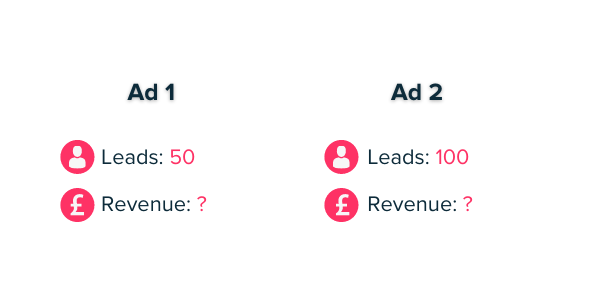
However, you’re missing a lot of data here.
With Ruler, you would see that for your recent PPC campaign, only 5 of those 100 leads go on to convert. They bring in £5,000 in revenue.
Your last PPC campaign meanwhile converted 20 leads, bringing in £20,000 in revenue.
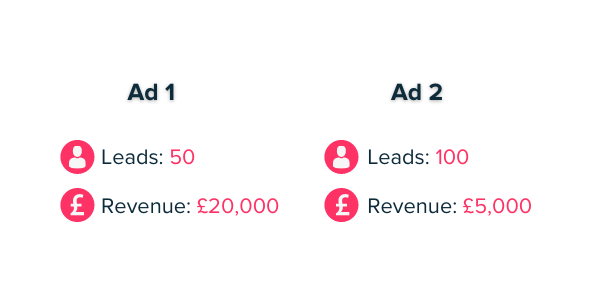
As such, your last PPC campaign was much more successful than your recent one. With attribution though, it’s hard to truly qualify what’s a success, and what isn’t.
If you tend to see long customer journeys or not, it can still be tricky to understand which channels are driving interest in your product or services, and which are acting as a catalyst for conversions.
This is where Ruler comes in.
Our customer journey report allows you to view your conversions by most frequent journey type. It means you can easily and quickly find patterns in channels (and content).
⚡️ Pro Tip
Tracking marketing touchpoints isn’t easy due to the limitations of Google Analytics. But there is a workaround. Ruler can help you track every stage of the customer journey.
Learn how to map your customer journeys here.
This will help you get those channels and content types to more people at the right stage of the journey. It’s essential data to supercharge your marketing.
Plenty of marketers work in eCommerce, meaning a customer comes to the website and can purchase directly online.
But plenty of marketers don’t.
If you’re one of those marketers that has to rely on offline sales channels, then we feel your pain. Tracking these conversions is hard work.
Even form submissions and live chat can be difficult to track. But Ruler can help.
💡 Pro Tip
Conversion tracking isn’t always easy. But it’s possible with the right tools. Learn how to track:
– Form submissions
– Phone calls
– Live chat conversations and conversions
Every single touchpoint, no matter if that’s a form, a call, even a store visit, you can link all of that data to your lead. It’ll mean more data for your sales team when they come to try to convert them.
It’ll also mean more data for your marketing team when they want to understand common customer journeys. You won’t have to deal with ‘direct’ as a lead source anymore!
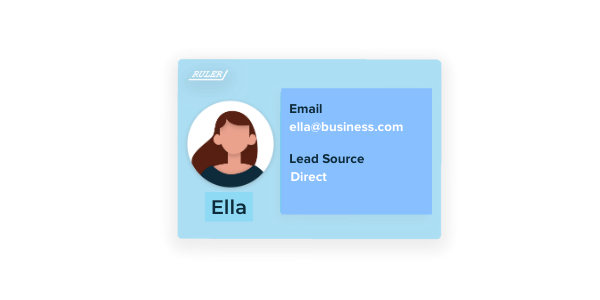
Customer journeys are complicated. Your customers are great at researching online. That means they’re going to be looking at you and all of your competitors. They’ll be assessing your content and engaging with whatever resonates most with them.
PPC is a great tool to both reach new audiences as well as reach existing ones already interested in your product or service.
Related: How to optimise your paid ads with offline conversion tracking
But it’s not so easy as setting up an ad campaign and getting the leads in. Users might see and engage with your ad, but not convert. Or they might convert into a lead as a result of your ad, but that’s it.
Without end to end marketing attribution, you’ll never get oversight of whether your ads are driving more than clicks and leads.
With Ruler, you can see full customer journeys and ensure that your ads get the recognition they deserve.
So, even if they form just part of a customer journey you can still ensure revenue is attributed back to it. That means a better and more accurate ROAS to help you optimise your campaigns.
If you work at a marketing agency, chances are you’re always looking for new opportunities to win new clients.
But it can be tricky proving the impact of your work. While vanity metrics, like clicks, likes and social growth are great at displaying how you grow the potential of a business’ marketing channels, how does it show growing sales?
And while conversion reporting can highlight your impact on lead generation, it still doesn’t show your impact on revenue.
Ruler Analytics can help you bridge that gap.
When you use Ruler across your client work, you’ll be able to get definitive stats that allow you to prove how your marketing work has impacted revenue.
So, if you’re pitching to a legal firm, you’ll be able to say, “Each month, our work helped drive 500 new clients. This was up from 35 per month.”
Watch the contracts roll in as you definitively prove your impact on business.
Related: Here’s what clients really want from their marketing agencies.
Long sales cycles are an obstacle for every marketer. As we said before, a website visitor isn’t going to convert first time, every time. Some could take twenty or even a hundred touchpoints to convert.
Particularly for high-value products, customer journeys tend to be long.
Related: How to shorten the sales cycle
But that doesn’t mean you can’t track those touchpoints.
With Ruler, you can track each and every touchpoint. Given Ruler is the go-between for your website, your CRM and your marketing tools, you’ll be able to send the data you need, where you need it most.
Ruler can track every call, every form submission, every web visit (and referring channel, campaign and keyword) plus so much more.
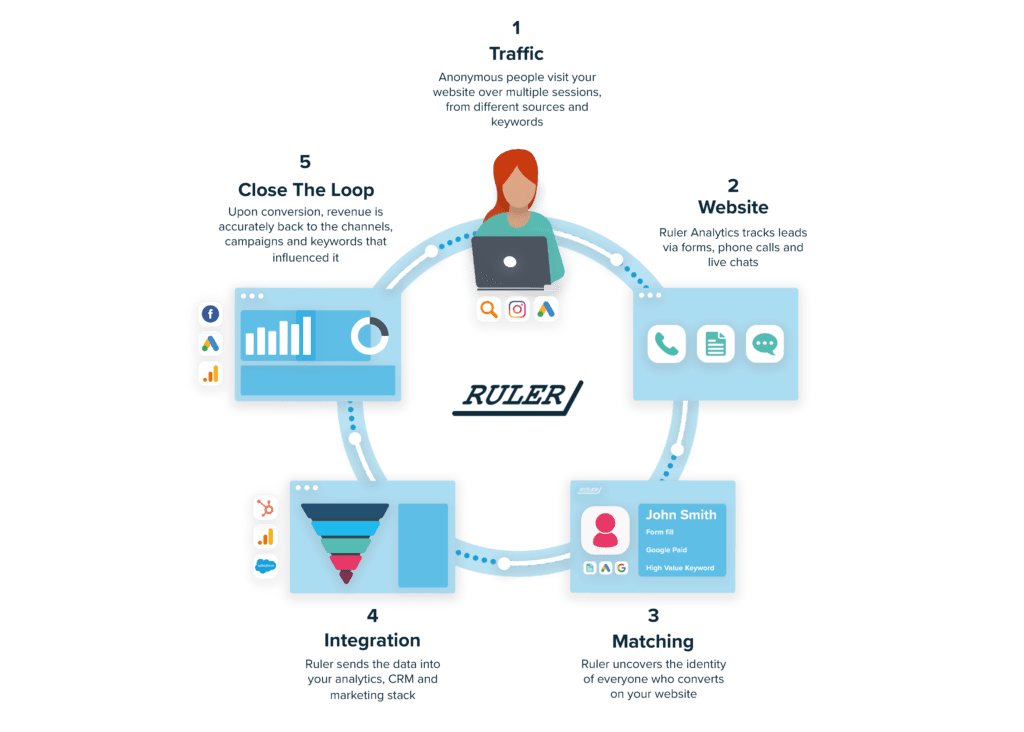
From there, you’ll be able to build common customer journeys that can help you shape your future content.
You might find that case studies work great to convert users who have previously engaged with your middle of the funnel blog pieces. So, on those blogs, you might add CTAs to case studies to help drive more conversions.
Or you might find that people who first engaged with your site from PPC went on to become closed revenue more than any other channel. That’s pretty good evidence to make a case for more PPC budget.
There are seven cases you’ll need to use Ruler for. But it doesn’t stop there. From customer journeys to opportunity pipelines, Ruler Analytics can support every nuance of your marketing strategy.
So why not get started? Book a demo with our team to see the data in action, and learn how you can get started with attribution.
